Incrementality measures the unique value your affiliate partners actually create—the sales, leads, and conversions that happen solely because of their efforts. It’s the difference between partners who drive genuine growth and those who simply take credit for sales that would have happened anyway.
For example, DMi Partners found that orders with affiliate touchpoints achieve a 27 percent higher average order value, demonstrating measurable impact beyond basic attribution.
As Lee Ann Johnstone, Founder of Affiverse, explains: “Affiliates touch customers in places and at times your own budget and content, and people sometimes can’t.”
This guide will show you how to measure incrementality accurately and use those insights to optimize your affiliate program. You’ll learn actionable strategies to identify your most valuable partners and make data-driven decisions that drive real growth.
One concept, many definitions: How brands interpret incrementality differently
So, what is incrementality in affiliate marketing? Incrementality measures the value that occurs solely due to a specific marketing channel or partner.
It reveals outcomes that wouldn’t have happened without these efforts, making it essential for assessing partnership performance and scaling impactful strategies.
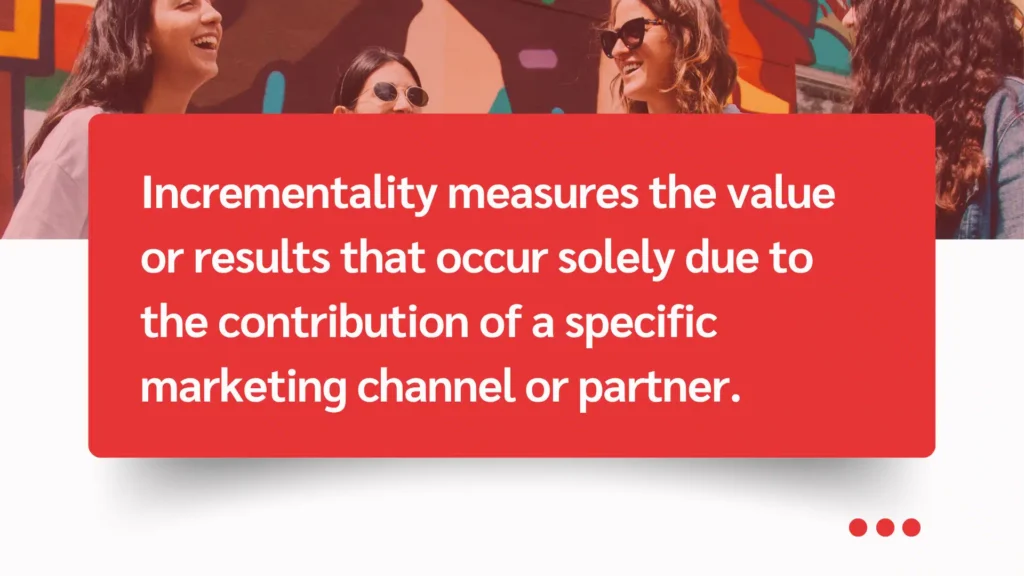
Different brands, however, interpret incrementality in various ways. While some see it purely as a measure of direct sales, others recognize its broader implications.
This broader perspective is echoed by Lacie Thompson, Chief Growth Officer at New Engen. She defines incrementality as “the new traffic that partners can drive, increasing the new customers that each partner is converting and tapping into understanding where they’re interacting in the conversion path.”
It’s not solely about conversions. It’s also about uncovering touchpoints and opportunities to add value across the customer journey.
Kayla Castro, Senior Manager of Affiliates and Partnerships at Zenni Optical, offers another lens. She states:
“I typically define incrementality as the additional value. So whatever that means to a brand, whether it’s a sale, an email sign-up, or a lead, whatever it is, the additional value that an affiliate would bring to the relationship that otherwise would be lost.”
This definition highlights incrementality’s flexibility and utility for brands seeking meaningful growth metrics.
6 reasons why brands can’t ignore the importance of incrementality
Measuring incrementality goes beyond understanding its definition to uncover the tangible benefits it provides. Explore why incrementality is a critical factor in optimizing partnerships and how it empowers businesses to build strategies that deliver lasting results
1. Accurately measures affiliate marketing impact
Incrementality pinpoints the true lift an affiliate delivers, such as the additional conversions that might not have happened without their involvement. It gives brands a better understanding of which affiliates drive results compared to those who coast through campaigns.
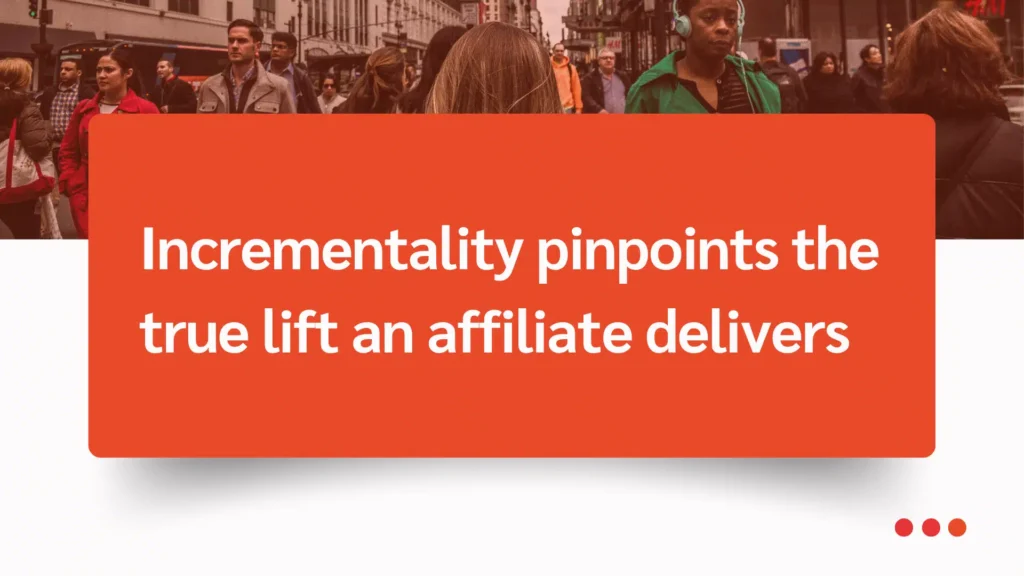
Plus, it separates organic results—conversions that would have happened anyway—from affiliate efforts. This is important for two reasons:
- Validation: Incremental data makes it easier to justify affiliate marketing to skeptical stakeholders. When you can point to revenue directly tied to affiliate actions, the value becomes undeniable.
- Fair rewards: It gives top-performing affiliate partners proper credit. This moves beyond last-click attribution.
Incrementality in action
Rugs Direct went beyond last-click attribution to accurately credit partners based on the value they provided. U-shaped attribution from impact.com helped reward partners at the top and bottom of the sales funnel. The results? 600 percent revenue growth and an 800 percent return on ad spend.
2. Optimizes marketing spend
Incrementality helps brands spend smarter, without asking for extra leeway or wiggle room in the marketing budget.

It shows which channels drive growth, helping brands shift budgets to high-impact areas.
Resource allocation is defensible with accurate data, even in tough budget conversations.
Incrementality in action
Beyond optimizing spend, measuring incrementality drives operational efficiency. Decathlon Canada’s team is a prime example, achieving a 20 percent boost in efficiency using impact.com’s comprehensive reporting suite. Here’s how the insights transformed their approach:
- Behavior Report revealed valuable customer interaction insights, enabling the team to adjust partner strategies and improve ad placements.
- Audience analysis highlighted data such as average order value (AOV) and same-day conversions, helping devise targeted commission plans that encouraged incremental sales.
- Advanced Action Listing Report mapped the entire customer journey, ensuring precise affiliate attribution and uncovering key conversion points.
- Brand Benchmarking Report provided performance comparisons within the sports industry, identifying areas for competitive advancement.
- Benchmark Partner Report ranked their affiliates, revealing top performers and enabling strategic support allocation.
The results were impressive. Within six months of launching Decathlon Canada’s program on impact.com, affiliate revenue surged by 533 percent. Conversion rates grew from 2.8 percent to 7.9 percent over three years.
3. Improves customer acquisition strategies
Incrementality removes the guesswork of customer acquisition. It shows which partners acquire new customers vs those targeting existing buyers.

With this clarity, marketers can use strategies backed by real performance data to target untapped audiences and lower acquisition costs.
4. Drive smarter decision-making
Changing strategies without solid data is the definition of “throwing spaghetti at the wall to see what sticks.”

Incrementality eliminates that uncertainty by using performance-backed insights to refine affiliate strategies and scale what works.
It helps brands move beyond basic attribution models to measure true affiliate impact, so brands can reward based on actual value, not just timing.
This kind of transparency builds trust with affiliates, strengthens partnerships, and ultimately drives better performance across the board.
Incrementality in action
Mapiful saw 12X revenue growth by refining its influencer marketing approach. The team used impact.com’s Partner Insights feature to identify high-performing partners who were crucial to the customer journey.
With this data, they took a strategic step forward. They successfully expanded their reach by recruiting 13,000 new partners modeled after their top contributors. These partners delivered substantial, incremental growth.
The result was exceptional. Revenue surged by 1200 percent, showcasing the power of data-driven partnership strategies. This approach offered new opportunities and created a strong foundation for long-term success in Mapiful’s influencer marketing program.
5. Enhance ROI measurement
Incrementality makes ROI impossible to ignore.
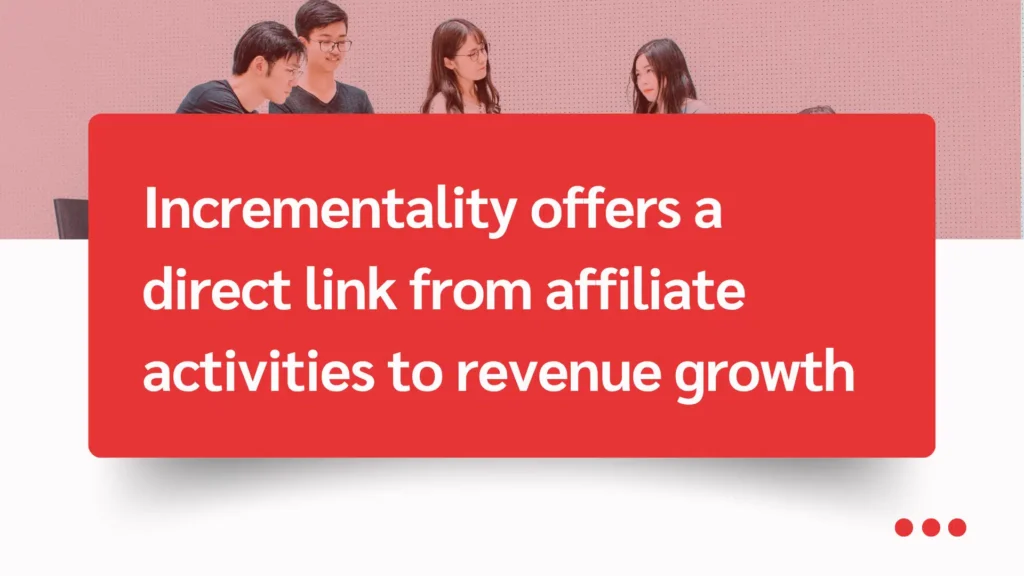
It offers a direct link from affiliate activities to revenue growth, making it easier to understand which efforts drive meaningful impact.
By quantifying the value of incremental conversions, brands gain the data they need to justify greater investment in high-performing affiliate programs and scale what’s working with confidence.
6. Support long-term growth strategies
When affiliates bring in new leads, they’re helping your brand create an audience of loyal customers.
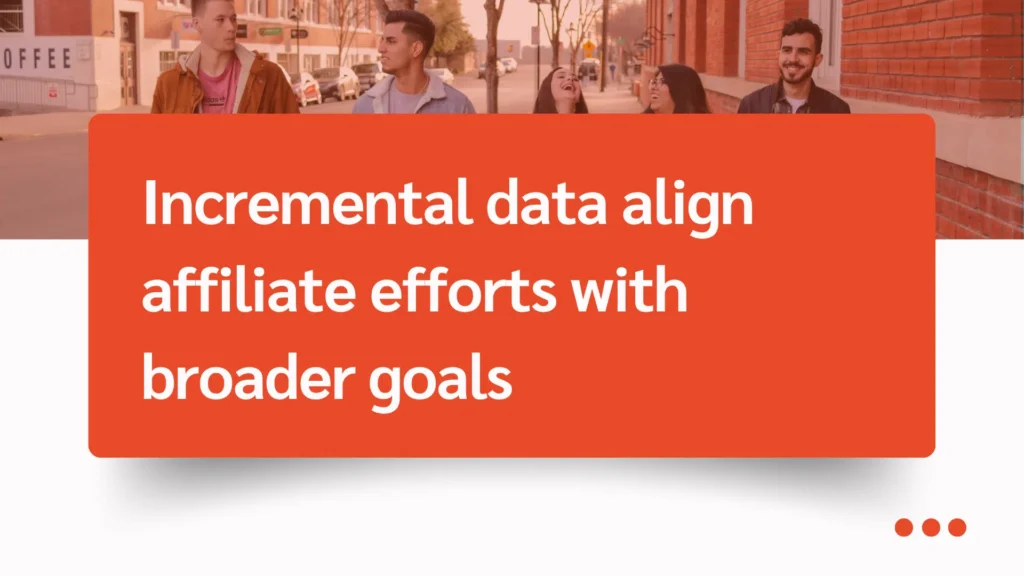
Incremental data helps align affiliate efforts with broader goals like boosting customer lifetime value, focusing less on quick conversions and more on long-term clients.
By understanding what truly drives growth, brands can scale the most effective partnerships and continuously optimize strategies to meet evolving audience and market needs.
What to measure to reveal the true value of your affiliate channel
To measure the true impact of your affiliate marketing channel, you need to understand what to measure, not just how to measure incrementality.
Tracking the right metrics is what separates guesswork from growth. Keep these key indicators in mind as you evaluate performance.
1. Total revenue touched by affiliate partnerships
Affiliate partnership revenue captures the revenue directly influenced by affiliate activity throughout the customer journey. This metric is critical for understanding the ROI of your affiliate program.

Key metrics to track include:
- Total sales attributed to affiliate links
- Percentage of overall revenue influenced by affiliates
- Average order value (AOV) of affiliate-driven sales
How to use total revenue for analysis:
- Compare affiliate-influenced revenue to other marketing channels
- Identify performance trends over time
- Evaluate the impact of affiliate promotions during peak sales periods
Separating affiliate-driven revenue from overall revenue gives brands a clear view of performance—this is especially helpful when justifying budget allocations or making the case for increased investment.
2. Revenue where affiliates were the sole touchpoint
This metric captures revenue from customers who interacted only with affiliate channels before purchasing—no organic search, paid ads, or other marketing touchpoints. It represents the most direct contribution affiliates make to your bottom line.
Key metrics to track:
- Percentage of sales driven exclusively by affiliates
- Conversion rates for affiliate-only journeys
- Time-to-purchase for customers influenced solely by affiliates
How to use these metrics for analysis:
- Evaluate how effectively affiliates drive standalone conversions
- Identify top-performing partners who serve as sole influencers
- Compare affiliate-only revenue to multi-channel revenue to better understand channel dependency

Understanding revenue driven solely by affiliate partners helps brands identify their top-performing affiliates—making it easier to align attribution models for fair rewards and compensation.
3. Customer journeys involving only affiliate channels
To better understand incrementality, tracking how customers interact only with affiliate channels throughout their buying journey is essential—excluding all other touchpoints such as paid social or organic search.
Key metrics to track:
- Number of customer journeys with only affiliate touchpoints
- Average number of affiliate interactions per journey
- Revenue generated from single-channel affiliate journeys
How to use these metrics for analysis:
- Map common affiliate-only paths to purchase
- Identify which affiliates dominate these single-channel journeys
- Evaluate how different affiliate types—such as content, coupon, or loyalty—contribute to conversions in these paths

Analyzing these journeys helps brands spotlight affiliate partners who are true demand drivers, strengthening the case for performance-based investment.
4. The relationship between credited revenue and total value created
Affiliates are more than traffic drivers—they’re strategic marketing partners who drive conversions and revenue. To fully understand their impact, it’s important to look beyond credited sales and consider the total value they generate.
Key metrics to track:
- Incremental revenue attributed to affiliates beyond credited sales.
- Lifetime value (LTV) of customers acquired through affiliates.
- Cross-channel uplift driven by affiliate campaigns.
How to use these metrics for analysis:
- Compare credited revenue to the total customer value generated.
- Assess the halo effect of affiliate campaigns on other channels.
- Identify affiliates that drive high-value customers or repeat purchases.
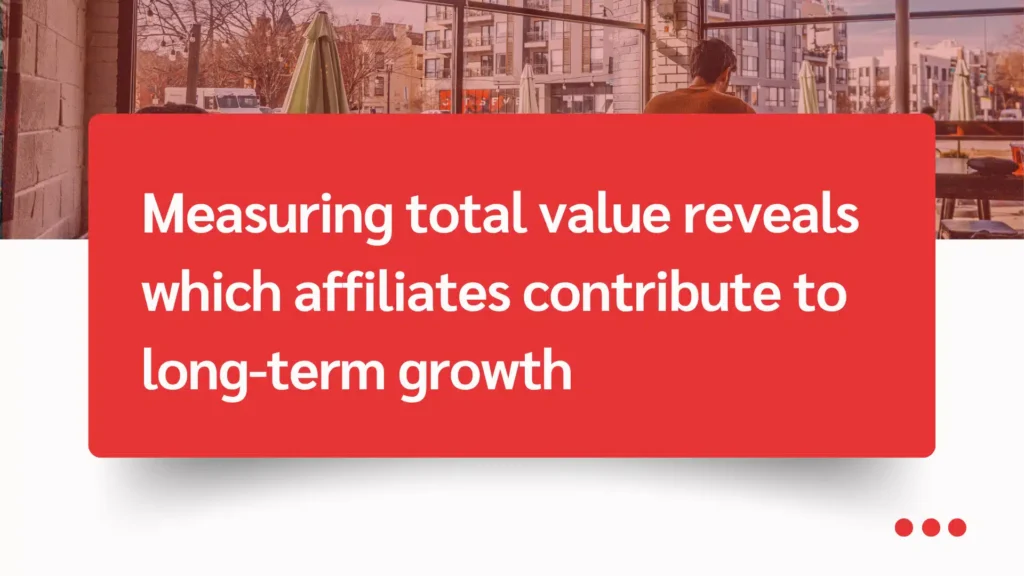
Measuring total value reveals which affiliates contribute to long-term growth, helping you prioritize partners who deliver sustained impact—not just short-term wins.
4 strategies to measure incrementality in affiliate marketing
Knowing your affiliate campaigns are working is one thing. Understanding how well they’re performing—and why—is another.
To fully grasp the full impact of affiliate marketing, brands need reliable methods to measure incrementality. Without reliable measurements, brands have little understanding of which affiliate efforts actually drive new value, compared to efforts that take credit for results that would have happened anyway.
By mixing measuring tactics, marketers learn what’s working, what’s not, and how to optimize for long-term success. Here’s how to measure affiliate incrementality.
1. AB testing for ROI impact
A/B testing offers a straightforward way to measure the real impact of affiliate marketing.

By comparing two nearly identical scenarios—one with affiliate activity and one without—marketers can isolate the incremental lift in leads and conversions that affiliates generate.
It’s a controlled method that filters out external noise, giving brands a clearer view of whether an affiliate campaign drives ROI or simply rides the wave of other marketing efforts.
How it works
To run an A/B test, split your audience into two matched groups: a test group and a control group. For fair comparison, these groups should be as identical as possible in size, demographics, and behavior.
The test group is exposed to the affiliate marketing campaign, while the control group is not.
Brands will want to use innovative tools such as subID tracking to identify affiliate and non-affiliate links and easily monitor them.
Once the campaigns run, analyze the difference in outcomes between the two groups. Key metrics to track include:
- Sales growth
- Customer acquisition rates
- Cost efficiency
Comparing these results helps you quantify the true lift generated by affiliate efforts, giving you the confidence to invest—or pivot—based on hard data.
Additional considerations
When implementing AB testing strategies, keep these factors in mind for optimal results:
- Test duration matters: See the test runs long enough to gather reliable data, especially for affiliates with lower traffic volume.
- Sample size: A large enough sample size is crucial to get statistically significant results.
- Regular reviews and iterations: Continuously analyze test outcomes and refine your strategies to keep up with dynamic market trends.
- Transparency with affiliates: Share testing objectives and results with affiliates to strengthen partnerships and align goals.
- Avoid one-size-fits-all strategies: Keep in mind that different programs may require customized approaches for accurate insights.
2. Partner journey analysis

Partner journey analysis is a strategic way to understand exactly when and how affiliates influence the customer journey. By analyzing engagement and attribution data, marketers can:
- Spot trends in affiliate-driven behavior
- Pinpoint high-impact touchpoints across the funnel
- Track how leads interact with affiliate content over time
These insights identify where affiliates deliver the most value, whether driving awareness at the top or nudging conversions at the bottom.
You can then place top-performing partners where they’re most effective, boosting conversions and growth.
How it works:
Partner journey maps are a data gold mine—but only if you set up proper metrics tracking. To visualize affiliates’ role in driving conversions, brands can leverage various innovative tools designed to collect and analyze key data.
Here are some useful tools to understand affiliates along the customer journey.
Multi-touch attribution models identify which touchpoints in a customer’s journey result in a sale. This shows how affiliates and other channels work together to drive outcomes. Notably, 75 percent of marketers rely on this approach to refine their strategies.
Cross-device tracking links multiple devices to the same user, offering clarity on consumer behavior across platforms. This reveals how affiliates interact with other channels throughout the customer journey.
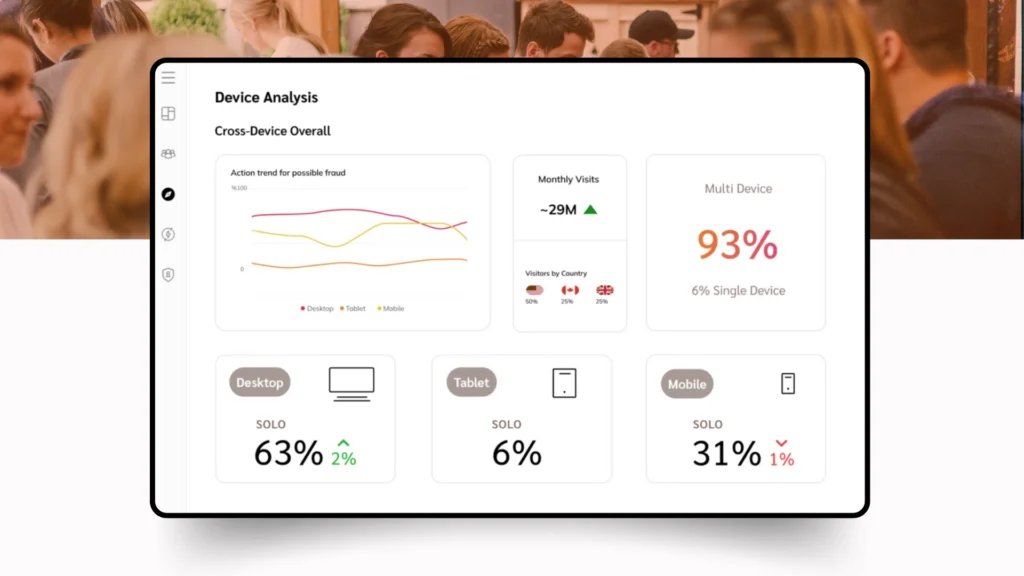
Contribution reporting measures the roles partners play in conversions by evaluating three key metrics:
- Solo touchpoints, where a partner is the only driver of a conversion.
- Credited conversions, where a partner receives conversion credit.
- Assisted actions, highlighting where a partner contributed to a conversion without owning the credit.
Brands use these insights to identify their most effective partners across the funnel. From here, they can fine-tune their partnership strategies and optimize their funnel for maximum impact.
Additional considerations
When implementing Partner Journey Analysis, brands should keep the following in mind:
- Data accuracy: Collect and maintain clean, reliable data to avoid errors and ensure trustworthy insights.
- Technology investment: Use advanced analytics tools that support comprehensive tracking and reporting across platforms.
- Define clear objectives: Set specific goals, such as identifying top partners or uncovering customer journey gaps, to guide your analysis.
- Regular updates and reviews: Periodically review and adjust strategies to keep pace with changing consumer behavior and market trends.
- Transparency strengthens partnerships: Share findings with affiliates to foster collaboration and encourage strategy alignment.
- Respect privacy regulations: Adopt tools compliant with laws like GDPR and CCPA to protect data and maintain customer trust.
3. Incremental surveys and studies

Incremental surveys and studies offer vital insights into how your affiliate program drives measurable growth.
While customer feedback is invaluable for understanding purchasing behavior and conversion drivers, expanding your approach to include input from partners promoting your products opens up new strategic opportunities.
Partner feedback helps uncover critical elements such as promotional challenges, audience preferences, and untapped marketing channels.
Combining insights from customers and partners can give you a more comprehensive understanding of your program’s performance. This approach highlights areas for improvement and identifies strengths, making it easier to refine tactics.
Qualitative feedback ensures your strategies resonate with real-world dynamics, building stronger customer loyalty and reinforcing productive partner relationships.
How it works
Brands can employ various effective tactics for gathering this data. Each method contributes valuable insight, clarifying what drives success and where opportunities lie for partnership or strategy enhancements.
Focus groups. Gather a small group of customers or partners to discuss your product or strategy. These sessions offer in-depth qualitative insights and help uncover pain points, preferences, and areas for improvement.
Online surveys. Distribute structured questionnaires to a broad audience. Surveys are ideal for collecting quick, measurable data on opinions, behavior, or satisfaction levels.
One-on-one interviews. Conduct detailed conversations with key customers or partners. This provides nuanced feedback that broader methods might miss.
A/B testing feedback. Pair performance data from A/B testing with follow-up questions for audience insights. This helps link engagement patterns with specific preferences or concerns.
Community polls. Use social platforms or forums to run quick polls. These are efficient for gathering pulse-check data on preferences or attitudes toward your brand initiatives.
Additional considerations:
Thoughtful planning is key to making incremental surveys and studies yield meaningful insights and drive impactful outcomes.
- Define clear objectives: Identify what insights you aim to gain, whether understanding partner challenges or customer preferences, to keep your efforts focused and valuable.
- Select the right method. Choose a method that suits your goals, such as focus groups for detailed discussions or surveys for broad data collection.
- Engage diverse participants. Include both customers and partners to capture a well-rounded perspective on your program’s performance and opportunities.
- Promise anonymity, if needed. Promote honest and transparent feedback by offering confidentiality for sensitive topics.
- Analyze and act on insights. Turn the collected data into actionable strategies, addressing key pain points and leveraging strengths for program improvements.
4. Incrementality reporting

Incrementality reporting showcases the true value affiliates contribute toward overall revenue goals. It’s a structured way to analyze and present the results of tests, surveys, and tracking efforts, making performance insights clear and actionable for stakeholders.
With these reports, decision-makers gain the data they need to optimize strategy, justify budget shifts, and confidently scale—or scale back—affiliate programs based on real impact.
How it works:
Brands use robust reporting capabilities to combine data from multiple measurement methods, such as A/B testing, partner journey analysis, and cross-channel tracking. The data is then presented in clear, visual formats.
Platforms such as impact.com automate this process by offering tailored incrementality reporting tools, including:
Incrementality Dashboard identifies which partners drive incremental sales, predicts the impact of removing certain partnerships, and highlights opportunities to enhance high-performing collaborations.
With tools like group benchmarks and detailed partner reports, you gain actionable insights to optimize your program and maximize ROI effectively.
Incrementality by Partner report breaks down key metrics such as revenue contribution, first-click impact, and solo-driven conversions.
This helps you identify partners that deliver true incremental results. With customizable filters and in-depth data comparisons, the report enables smarter decision-making to optimize partnerships and boost return on investment.
Data Lab empowers businesses to create custom reports tailored to their unique needs, providing insights that go beyond standard data sets. Intuitive tools for filtering, crafting visualizations, and building specialized metrics deliver a fully customizable reporting experience.
Whether you’re answering specific business questions or piecing together complex data, Data Lab provides the flexibility to turn information into clarity and drive smarter decisions.
Additional considerations:
Successful incrementality reporting requires a clear strategy and attention to detail to uncover actionable insights.
- Know your endgame. Start with crystal-clear goals, whether it’s pinpointing top-performing partners or reallocating marketing budgets. Purpose drives precision.
- Arm yourself with smart tech. Invest in tools that seamlessly integrate tracking, analytics, and reporting. A unified platform saves time and ensures precise data.
- Bring the team on board. Demystify incrementality for everyone involved. When all stakeholders understand the benefits, alignment becomes effortless.
- Keep pace with the market. Regularly revisit your models to stay ahead of evolving consumer habits and industry shifts. Agile reporting leads to smarter moves.
FAQ
Incrementality measures outcomes that happen because of a specific marketing effort. In affiliate marketing, incrementality helps determine sales or identify leads that occurred with the help of an affiliate partner. It helps determine if your affiliate programs work and enables you to identify high-performing affiliates.
It’s important to measure incrementality for a couple of reasons. This measurement helps brands understand where to get the best use out of their marketing spend. It also helps determine if their affiliate marketing programs—and the partners that support them—are effective. Without incrementality, brands risk overpaying for conversions that likely would have happened anyway.
Marketers can test incrementality using A/B testing, cross-channel marketing, or partner journey analysis. These methods help identify affiliate activity and measure the true lift to sales, leads, and conversions. Tools like impact.com help provide advanced data that highlight incremental revenue and ROI.
Drive confident decisions by understanding incrementality
Affiliate marketing is a go-to marketing strategy for many brands. It drives leads, increases brand awareness, and levels up revenue and ROI. Truthfully, without affiliate help, some of the coveted events, such as gaining a new lead or a repeat customer, might not occur.
Incrementality offers a complete look at what it takes to produce a desired outcome. It helps measure everything from a brand mention on a partner’s post to an affiliate helping a lead decide to hit “buy now” on a product. With those measurements, affiliate partners can be fairly rewarded for their efforts.
Understanding channel interactions helps marketers optimize efforts and allocate budgets more effectively. With the right mix of methods and tools—like impact.com—measuring incrementality becomes more than a metric—it’s the tool to provide continued affiliate success.
Learn more about impact.com resources to help you build clarity around the true value of your partnerships program to drive confident decisions and incremental value.
- The incrementality playbook: Prove your affiliate revenue’s true impact [research report]
- Affiliate marketing: How to give your business the strategic edge [ebook]
- Beyond basic tracking: 5 data-driven strategies to transform your affiliate program’s ROI [blog]
- Growing your business through digital partnerships [PXA free course]
- What is affiliate tracking? The basics for publishers [blog]





